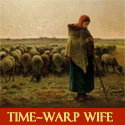 Have you ever wondered why brides do the things they do? Where the wedding day traditions came from? As this is June ~ 'the wedding month' ~ I thought I would share a few of the traditions, and their reasons, that my girls discovered when they researched them for a homeschool projects.
Have you ever wondered why brides do the things they do? Where the wedding day traditions came from? As this is June ~ 'the wedding month' ~ I thought I would share a few of the traditions, and their reasons, that my girls discovered when they researched them for a homeschool projects.
Blessings from Ohio...Kim<><
~~~~~~~~~~~~~~~~~~~~~~~~~
The Tradition of the Bridal Shower?
Tradition says that the first bridal shower was given to a poor couple in Holland who was denied the bridal dowry because of the groom's lowly miller status. The miller's friends showered the bride with gifts to help them set up housekeeping.
Why a Matchmaker?
For centuries, the matchmaker enjoyed the honored, if occasionally ridiculed, position of ensuring ethnic identity and compatibility. Groups that wanted this assurance regularly employed the services of a matchmaker, whose commission was a certain percentage of the dowries. Today, the modern version of the matchmaker is found as easily as turning on your computer. Computer programs can allegedly match individual backgrounds and traits so accurately that two people brought together for a date can be assured of "common interests" at the very least. In any event, it is only the dating that can be arranged, not marriage. So matchmaking of a sort has not disappeared; it has merely changed its appearance and emphasis, as is the case with any custom that expresses enduring human needs.
Why an Engagement Ring?
In the early days of "Marriage by Purchase," the betrothal ring served a twofold purpose. This twofold purpose included partial payment for the bride and was a symbol of the groom's honorable intentions. The diamond was found first in Medieval Italy, and because of its hardness, was chosen to stand for enduring love.
Why Does the Bride Wear White?
The color white has been a symbol of joyous celebration since early Roman times. At the beginning to the twentieth century, white stood for purity as well. Today, with the renewed interest, if not necessity, of staying pure until marriage, more Christian brides are electing to wear white instead of the recently trendy 'champagne'.
Why Does the Bride Wear a Veil?
The bride's veil and bouquet are of greater antiquity than her white gown. Her veil, which was yellow in ancient Greece and red in ancient Rome, usually shrouded her from head to foot, and has since the earliest of times, denoted the subordination of a woman to man. The thicker the veil, the more traditional the implication of wearing it.
According to tradition, it is considered bad luck for the bride to be seen by the groom before the ceremony. As a matter of fact, in the old days of marriage by purchase, the couple rarely saw each other at all, with courtship being of more recent historical emergence.
According to tradition, it is considered bad luck for the bride to be seen by the groom before the ceremony. As a matter of fact, in the old days of marriage by purchase, the couple rarely saw each other at all, with courtship being of more recent historical emergence.
The lifting of the veil at the end of the ceremony symbolizes husbandly leadership. If the bride takes the initiative in lifting it, thereby presenting herself to him, she is showing disrespect to her groom.
Veils came into vogue in the United States when Nelly Curtis wore a veil at her wedding to George Washington's aid, Major Lawrence Lewis. Major Lewis saw his bride to be standing behind a filmy curtain and commented to her how beautiful she appeared. She then decided to veil herself for their ceremony.
Why a Bride's Handkerchief?
Early farmers thought a bride's wedding day tears were lucky and brought rains for their crops. Later, a crying bride meant that she'd never shed another tear about her marriage. Today, we carry a handkerchief to dab away the tears of happiness and joy. How special to keep your wedding hanky and pass it down from mother to daughter capturing all the love and emotion of such a special event from one generation to another.
Why the Blue Satin Garter?
Why this "Something Blue?" In ancient Israel, brides wore a blue ribbon to signify "fidelity." The garter-throwing itself derives from a bawdy ritual called "flinging the stocking." In Britain, the guests would playfully invade the bridal chamber. The ushers grabbed the bride's stockings; the maids took the groom's. They took turns sitting at the foot of the bed flinging the stockings over the heads of the couple. Whoever's stocking landed on the bride's or the groom's nose would be the next to wed.
Today, many brides will wear two garters. The one she wishes to keep as a memento of her wedding day, possibly to be displayed on her grooms rear view mirror, and another, to be retrieved and tossed by the groom to all the young unmarried men attending the event. The "toss garter" is likely to be in the color of the wedding, and not as elaborate as the more decorative garters kept by the bride. Whoever catches the garter will be the next to marry.
Today, many brides will wear two garters. The one she wishes to keep as a memento of her wedding day, possibly to be displayed on her grooms rear view mirror, and another, to be retrieved and tossed by the groom to all the young unmarried men attending the event. The "toss garter" is likely to be in the color of the wedding, and not as elaborate as the more decorative garters kept by the bride. Whoever catches the garter will be the next to marry.
Why Something Blue?
Brides of ancient Israel wore blue ribbons on the border of their wedding cloths to denote, love, modesty and fidelity. These are ideals still associated today with that color. Blue is also the most popular wedding color. Also see, "Why the Blue Satin Garter."
Why Does the Bride Carry Flowers?
For centuries, flowers have stood for a variety of emotions and values. Roses for love, lilies for virtue and so on. In ancient marriages, the brides carried herbs beneath their veils to symbolize fidelity. Greek brides carried ivy as a symbol of never-ending love. Orange blossoms, (the world renowned wedding flower) were chosen by the Spaniards to represent happiness and fulfillment, because the orange tree flowers and bears fruit at the same time. During even earlier times of "primitive marriage," when the fear of demons was most prevalent, the brides carried stinking garlands of herbs and spices for the purpose of frightening off evil spirits.
Today, brides carry flowers in the color scheme of their wedding, bringing beauty and elegance as well as old world customs to their special day. Have you considered spelling out the name of your groom in the flowers of your bouquets? [The center of my bouquet was made so that it would come out and become my going-away corsage! KW<><]

Giving the Bride Away?
In times when women were granted few privileges and even fewer personal rights, the bride was literally given away to the groom by the father, usually in exchange for monetary gain. Today, it is seen as symbolic of the blessings and support of her union as a promise of continued trust and affection. Often when the question is asked by a clergy during the ceremony, "Who gives this woman to be married to this man," the father's response is, "Her mother and I."
Why a Wedding Ring?
The circular shape of the wedding ring has symbolized undying, unending love since the days of the early Egyptians. A primitive bride wore a ring of hemp or rushes, which had to be replaced often. Durable iron was used by the Romans to symbolize the permanence of marriage. Today's favorite is of course, gold, with it's lasting qualities of beauty and purity.
Why Do the Attendants Dress Alike?
Who hasn't noticed that the maids, ushers, and entire bridal party dress very much like the bride and groom? It was once common for the bride, her groom and all their friends to walk together to the church on the morning of the wedding. Afraid that someone, maybe a rejected suitor, would spot the happy couple and put a curse on them. The groom's friends wore clothes almost identical to his, and the women costumed themselves like the bride. These disguises tricked evil wishers into letting the real bride and groom live happily ever after. Of course, today we dress our attendants alike for the beauty and pageantry of the event.
Why a Wedding Cake?
Beginning in early Roman times, the cake has been a special part of the wedding celebration. A thin loaf was broken over the bride's head at the close of the ceremony to symbolize fertility. The wheat from which it was made, symbolized fertility and the guests eagerly picked up the crumbs as good luck charms. During the Middle Ages, it became traditional for the couple to kiss over a small cluster of cakes. Later, a clever baker decided to amass all these small cakes together, covering them with frosting. Thus, the modern tiered cake was born. From a Christian perspective, the couple feeding each other a piece of cake & serving each other a the drink from a toast, this service symbolizes their first communion as husband and wife. Maybe more couples should be more respectful of this tradition.
The Groom's Cake
The Groom's Cake
The groom's cake is a smaller cake that is served at the wedding reception.Young women (unmarried) would take a piece of the groom's cake home to place under their pillows and the old wive's tale says "they will marry whomever they dream of that night."
Why Old Shoes and Rice?
The throwing of rice on the couple has always been symbolic of wishing prosperity and good luck. In the Orient, throwing rice means, "May you always have a full pantry." Wheat and other grains are sometimes thrown in addition to rice, thereby also wishing prosperity and lack of want. Each shower bestows "Goodwill Traditions" of wealth upon the newlyweds. To this day, rice remains a token of a life of "plenty."
Why a Trousseau?
The word trousseau came from the French word, trousse, which meant bundle. The trousseau originated as a bundle of clothing and personal possessions the bride carried with her to her new home. This was later expanded upon into a generous dowry. Today, the trousseau includes all of the new items for the household, as well as for the bride herself. 

Why the Honeymoon?
In ancient times, many of the first marriages were by capture, not choice. When early man felt it was time to take a bride, he would often carry off an unwilling woman to a secret place where her relatives wouldn't find them. While the moon went through all its phases, (about 30 days) they hid from the searchers and drank a brew made from honey. Hence, we get the word, honeymoon.
Why Carry the Bride Across the Threshold?
During the days of "Marriage by Capture," the bride was certainly not going to go peacefully into the bridegroom's abode, thus, she was dragged or carried across the threshold. In even earlier times, it was believed that family demons followed the woman and to keep her family demons from going into the groom's home, she was carried across the threshold upon her entering for the first time. After that, the demons could not enter as she would come in and go out of the home.




















 Edinburgh
Edinburgh








































































VERY interesting!!!!!!
ReplyDelete